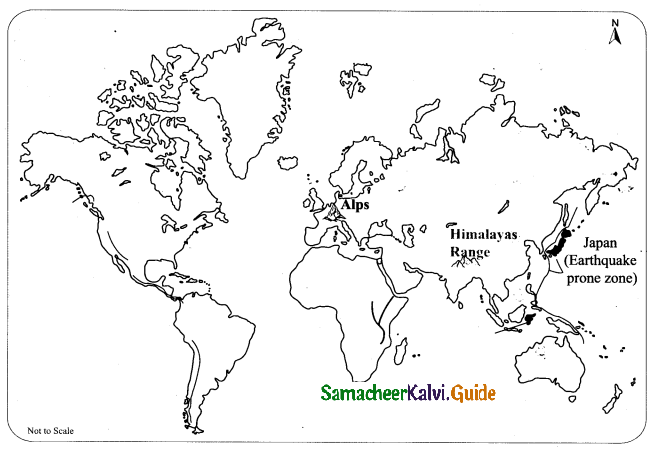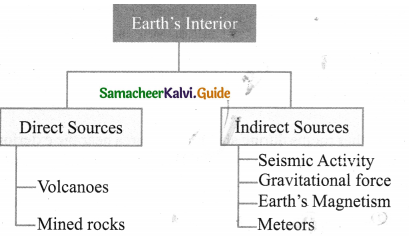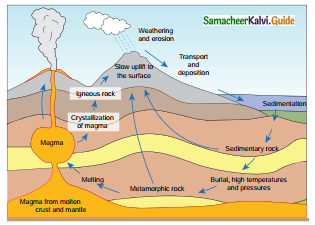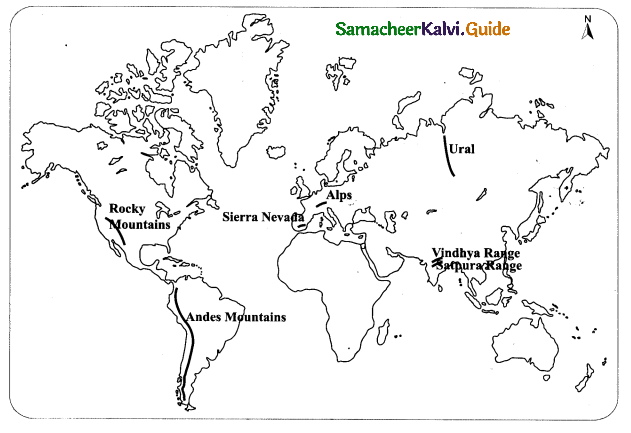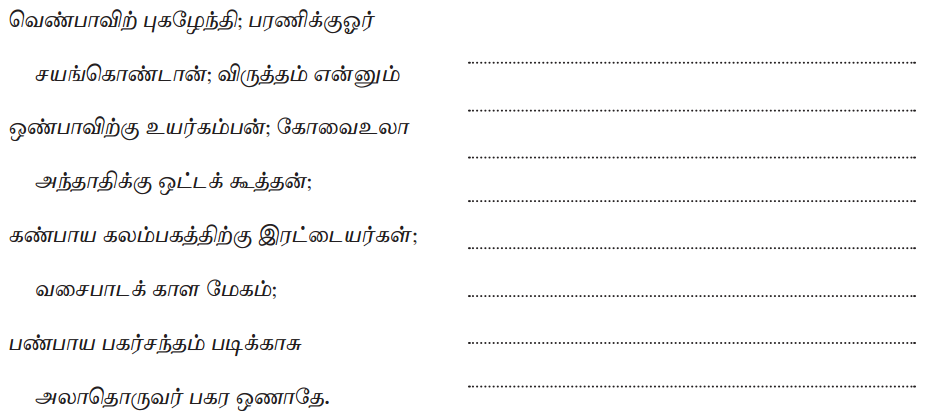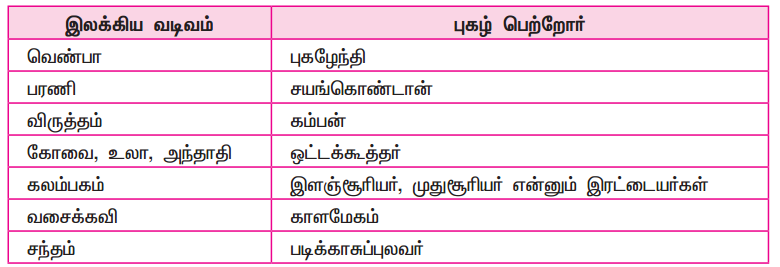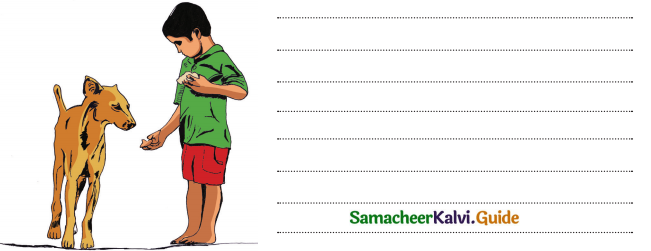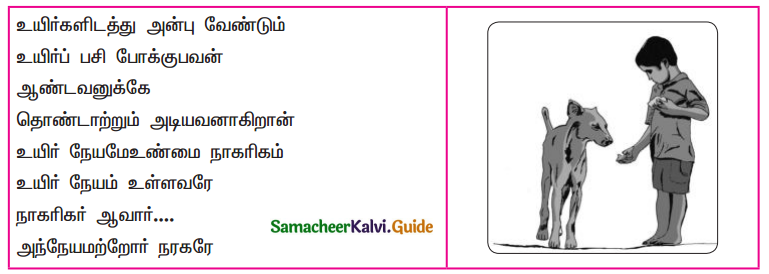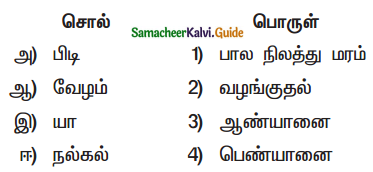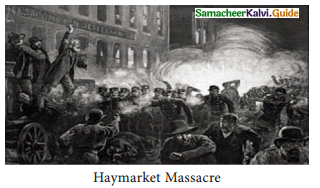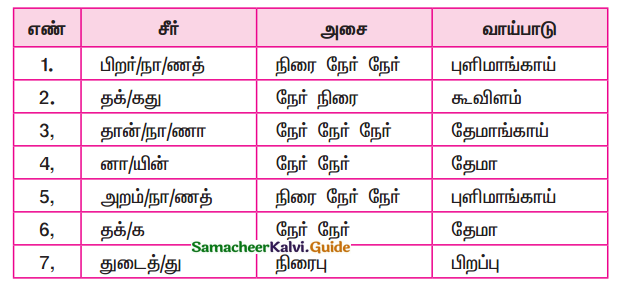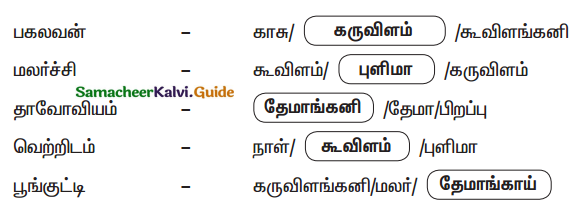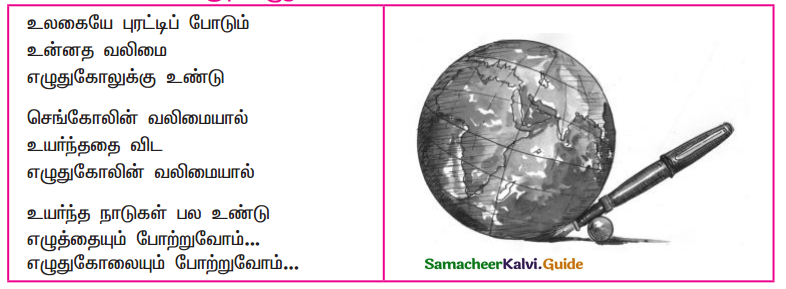Tamilnadu State Board New Syllabus Samacheer Kalvi 9th English Guide Pdf Prose Chapter 1 Learning the Game Text Book Back Questions and Answers, Summary, Notes.
Tamilnadu Samacheer Kalvi 9th English Solutions Prose Chapter 1 Learning the Game
9th English Guide Learning the Game InText Questions and Answers
Question 1.
Who were Sachin’s favourite players?
Answer:
Sunil Gavaskar and the West Indian legend Viv Richards were Sachin’s favourite players.
Question 2.
What was special about Shardashram Vidyamandir in Mumbai?
Answer:
At Shardashram Vidyamandir in Mumbai, Ramakant Achrekar Sir was the cricket coach who gave due importance to the game of cricket. This was special about it.
![]()
Question 3.
What was the opportunity that transformed the life of Sachin?
Answer:
The opportunity to join Achrekar Sir’s camp involving a session in the morning and evening at Shivaji Park transformed the life of Sachin.
Question 4.
What sort of conversations did Ajit and Sachin have while travelling?
Answer:
The conversations were about the nuances of batting. Sachin enjoyed them a lot. (Ajit gave som thoughts about batting. It served as a personal coaching manual).
Question 5.
What routine did Sachin follow in washing his clothes?
Answer:
Sachin had only one set of cricket clothes and the routine was to wash them as soon as he’d return from the morning session. While he had his lunch, the clothes would dry out in the sun and he would wear them again in the afternoon. The pattern was repeated in the evening so that he could use the same set of clothes the following morning.
![]()
Question 6.
What did Achrekar inform Ajit?
Answer:
Achrekar informed Ajit that Sachin had the potential to be a good cricketer if he practised all year round.
Question 7.
What was the suggestion given by Achrekar to Sachin’s father?
Answer:
Achrekar suggested that Sachin should change schools if he wanted to pursue cricket seriously, since the New English School in Bandra, where Sachin was studying, did not have cricket facilities.
Question 8.
What acted as a safety valve?
Answer:
Cricket acted as a safety valve.
![]()
Question 9.
What did Sachin do during the thirty minutes break?
Answer:
During the thirty-minute break, Sachin would often have a vada pav, a popular Mumbai fast food, with the money that Achrekar sir would give him.
Question 10.
What is the intense ‘fifteen minutes’ mentioned?
Answer:
The intense fifteen minutes is the last part of his session. Sir would keep a one rupee coin on the top of the stumps. About sixty to seventy boys in fielding would bowl to him. He had to hit every ball along the ground to survive and win the one rupee coin.
Question 11.
What did Sachin’s father do just to make Sachin happy?
Answer:
Occasionally, Sachin’s father took him home. Sachin would always ask his father to treat him to a special fruit cocktail at a juice centre near the club. Though it was a little unreasonable, his father would give him what he wanted, just to see him happy.
![]()
Question 12.
What embarrassed Sachin in the bus?
Answer:
At peak hours it was hard to get a seat, it was a challenge just to stand with the kitbag. The conductors inevitably complained about Sachin that he had taken up the space of another passenger. They were often rude and sometimes asked him to buy two tickets. This embarrassed Sachin in the bus.
Question 13.
What made Sachin forget, to go to the nets?
Answer:
Occasionally, while playing with his friends at home, Sachin would conveniently forget to go to the nets amidst all the fun.
![]()
Question 14.
What did Achrekar advise Sachin?
Answer:
Achrekar advised Sachin not to waste his time playing insane games with those kids. He told him that cricket was waiting for him at the nets, he asked him to practise hard and see what magic it could transpire.
9th English Guide Learning the Game Textbook Questions and Answers
A. Answer the following questions in one or two sentence
Question 1.
What was coach Achrekar’s first impression of Sachin?
Answer:
Sachin felt more at ease and started to hit the ball well. This was coach Achrekar’s first impression on Sachin.
Question 2.
Why did Sachin feel that the schedule of the camp was ‘rigorous’?
Answer:
The camp involved a session every morning and evening at Shivaji Park, he practised between 7.30 am and 10.30am. He would return in the afternoon and practise till late evening. He was exhausted by the end of the day. Thus the schedule of the camp was ‘rigorous’.
![]()
Question 3.
What did serve as a very personal coaching manual to Sachin?
Answer:
Sachin’s brother Ajit gave him a note containing some thoughts about batting. This served as a very personal coaching manual.
Question 4.
Why was Sachin asked to change the school?
Answer:
Sachin’s school had no cricket facilities. So he was asked to change the school if he wanted to pursue cricket seriously.
Question 5.
What was the condition laid down by Sachin’s father for changing the school?
Answer:
Sachin was really serious about playing cricket. Sachin’s father said that if he should do so. he must change the school.
![]()
Question 6.
How did the act with the one rupee coin help Sachin become a good cricketer?
Answer:
Winning the one-rupee coin used to give Sachin immense satisfaction, if taught him to concentrate even when he was physically drained. Thus he became a good cricket.
Question 7.
What helped Sachin to build his physical and mental stamina?
Answer:
Sachin repeated the practice right through his summer holidays. The routine helped him build up physical and mental stamina.
Question 8.
Which incident triggered the coach to be angry on Sachin?
Answer:
Once, Sachin bunked his daily evening practice to watch an inter-school cricket match not anticipating ‘ that Sir would be there. So the coach was angry.
Question 9.
Why do you think Achrekar punished Sachin?
Answer:
Achrekar punished Sachin when he tried to him a very important lesson. I think it was because he might have been inattentive.
![]()
Question 10.
‘I owe myself to him’ – What does Sachin mean by this?
Answer:
‘Achrekar Sir made Sachin a great cricketer. He is grateful to him and his training. So he means to comment T owe me to him’.
B. Answer the following in a paragraph of 120 – 150 words.
Question 1.
‘Achrekar was a sincere coach’ – substantiate.
Answer:
Ramakant Achrekar started playing Cricket in the year 1943 when he was eleven. His most famous student is undoubtedly Sachin Ramesh Tendulkar, India’s Highest run-scorer in both Tests and ODIs and also the current record holder for multiple records! He has been instrumental in grooming some of the country’s most renowned cricketers like Vinod Kambli, Ajit Agarkar, and Romesh Powar.
Achrekar coached young cricketers at Shivaji Park, Dadar in Mumbai. Sachin trained under him when he too was just eleven, while he was a student at the New English School, Mumbai. Later Sachin was asked to change to Shardashram Vidyamandir, Mumbai where he coached. When he was young, Tendulkar would practice for hours and hours in the nets. If he became exhausted, Achrekar would put a one-rupee-coin on the top of the stumps, and the bowler who dismissed Tendulkar would get the coin.
If Tendulkar passed the whole session without getting dismissed, the coach would give him the coin. Such a motivational reward from the coach made Tendulkar strive and survive to win the coin. Tendulkar recalled an incident when his coach told him to play for ‘B’ team of his School. Instead of batting, he preferred sitting in the gallery and cheering for his schoolmates. In the evening, when he came across Achrekar, he was asked how many runs he had scored. Taken aback, Tendulkar told him that he was clapping and cheering up. Then came a slap which shattered his myth. He realized what a mistake he had committed. Achrekar told him firmly that he was not born to just clap for others but for others to watch him and clap for him.
![]()
Question 2.
Narrate in your own words the hardships undergone by Sachin to become a great cricketer.
Answer:
Topic: Learning the Game
Author : Sachin Tendulkar
Characters: Sachin, Ajit (brother), Dad, and Achrekar Sir. (Coach)
Theme: There is no substitute for hard work
(OR)
From very early age, Sachin played tennis ball cricket with his colony friends. Sunil Gavaskar and Viv Richards of West Indian were his favourite players, He loved both batting and bowling, Achrekar Sir who was the cricket coach at Shardashram Vidhyamandir in Mumbai. He ran summer camps too. Sachin’s brother Ajit took him for a trial at the camp. Sachin tried his best and joined the camp. The camp involved a session every morning and evening at Shivaji Park. Sachin practised between 7.30 am and 10.30 am. In the afternoon he practised till late evening.
The schedule was rigorous and he was i exhausted by the end of the day. His travelling from Bandra to Shivaji park was very tedious. Having only one set of cricket uniform clothes, he washed and dried it to wear them again in the afternoon, it was repeated in the evening to use them the next morning. On the advice of Achrekar, he moved to Shardhashram as he was serious in playing cricket. All his excess energies were getting channeled into 1 cricket. He played fifty-five practice matches during the summer break of sixty days. Apart from his summer sessions between 7.30 am and 4.30 pm, his evening session started at 5pm after only a thirty 1 minutes break. Between 5pm and 7pm he had five more net sessions.
Achrekar Sir placed a one rupee coin on the top of the stumps. If he managed to avoid getting out, the coin was his. There were sixty to seventy boys bowling to him. He hit every ball along the ground to survive those intense fifteen minutes. It gave him immense satisfaction and taught him to concentrate even when he was physically drained. The conductors were rude to him when he stood with kitbag in the bus. Dirty clothes often added to the embarrassment. Achrekar Sir warned him not waste his time playing insane games with his friends, One day Sachin was punished by his coach. Once he bunked daily evening practice and Sir was angry with him. He owed himself to his coach Achrekar Sir.
“Hard work pays rich dividend”
(OR)
From very early age, Sachin played cricket. His favourite players were Sunil Gavaskar and Viv Richards. Achrekar Sir was at Shardhashram as a cricket coach. He also ran a summer camp. Ajit took Sachin for a trial at the camp. Sachin impressed Sir and joined the camp. It was at Shivaji park. The sessions were held every morning and evening. He had rigorous practice for several hours. He was exhausted by the end of the day.
His to and fro journey from his home to Shivaji park was very tedious. He had only one set of uniform clothes. The routine was to wash them and dry out in the sun and wear it morning and after noon in turn. On Achrekar’s advice he moved to Shardhashram where cricket facilities were available. He practised cricket seriously. All his excess energies were channelled into cricket, he played 53 practice matches during the summer break of 60 days. He had his summer sessions between 7.30am and 4.30pm. With a thirty minutes break it started at 5pm. Between 5pm and 7pm he had five more net sessions. Achrekar placed a one rupee coin on the top of the stumps.
Sachin avoided getting out to own the coin. About seventy boys were fielding to bowl Sachin. He hit every ball and safe guarded himself. It gave him immense satisfaction and concentration though he was physically drained. The conductors were rude when he stood with his kitbag in the bus. Dirty clothes often added to his embarrassment. Achrekar warned him to avoid playing insane games with the kids. The coach punished him one day while teaching him an important lesson. Once he bunked daily evening practice and Sir was angry with him. Sachin owed himself to his cricket coach.
“Hard work pays rich dividend”
![]()
Question 3.
Quote the sentences which you find most inspiring from ‘Learning the Game’. How do they inspire you? Explain.
Answer:
‘The most inspiring sentences that I find in this lesson ‘Learning the Game’ are ;
‘Practise hard and see what magic can transpire’
‘Choose something you enjoy and really want to do and you will be successful’
These two are the utterances of the cricket coach Achrekar Sir. He was the cricket coach at Shardashram Vidhyamandir. He was running a summer camp too. Sachin went for a trail at the camp. Though he was nervous initially, he impressed the coach with his batting finally. Sachin had to undergo a rigorous practice at the camp. His travelling from his home in Bandra to the camp at Shivaji park was very tedious. Though he loved cricket, occasionally he played with his friends at home, conveniently forgetting that he had to go to the nets.
Achrekar was strict and would spot him in the melee and virtually drag him out. He would come up with excuses but sir would have none of it. He would get him to cliange and head off to Shivaji park. At this juncture sir advised him to practise hard and see what magic can transpire. He also asked him to choose his carreer he enjoyed and wanted to do and he would be successful. Sachin followed this advice religiously despite all the hardships. He admired the farsightedness of Achrekar Sir. Sachin practised hard enough and made the people across the world watch him play.
Had it not been for sir, Sachin would not be the cricketer he turned out to be. Sachin confesseds that he owed himself to his cricket coach Achrekar sir.
“There is no substitute for hard work”
(OR)
‘Practise hard and see what magic can transpire’
‘Choose something you enjoy and really want to do and you will be successful’.
These are the most inspiring sentences I find in this lesson ‘Learning the Game’.
The cricket coach Achrekar sir advises Sachin Tendulkar through these sentences, he was a Shardashram Vidhyamandir. he ran a camp too. Sachin joined the camp at the mercy of the coach, he impressed the coach, he underwent a rigorous training in the camp. He loved playing cricket. He travelled from bandra to church gate either by bus or train. He bore all the difficulties carrying his kitbag daily. He was often embarrassed by the conductors in the buses.
His coach did not allow him to play with his friends. He was strict and would spot him in the melee and drag him out. He would come up with excuses but Sir would have none of it. Though he hated being dragged off he looked back and admired Achrekar’s far sightedness. Sachin chose cricket, practised very hard and became a prominent cricketer following the advice of his disciplinarian coach. He openly said that he owed himself to Achrekar Sir.
![]()
Vocabulary
C. Match the words in column A with their synonyms in column B.
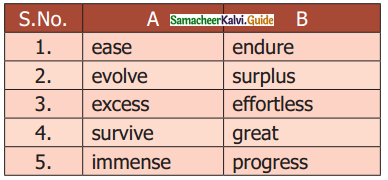
Answer:
- c
- e
- b
- a
- d
D. Match the words in column A with their antonyms in column B.

Answer:
- b
- e
- d
- a
- c
E. Use the words given below in your own sentences so as to get different meanings, one is done for you.
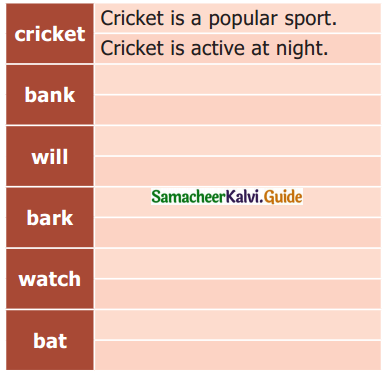
Answer:
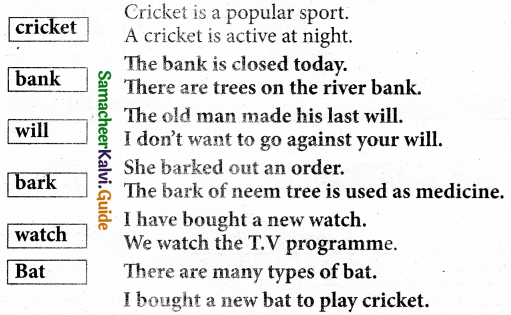
F. Consult a dictionary, to find the homophones for the given words.
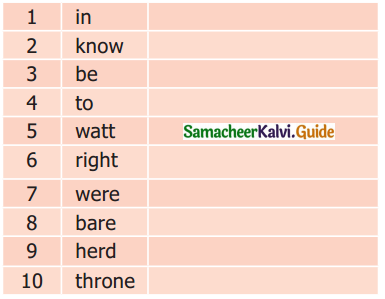
Answer:
- inn
- no
- bee
- two
- what
- rite
- where
- bear
- heard
- Thrown
![]()
G. Look at the prefixes given and frame two new words for each prefix and suffix. One is done for you.

Answer:

Listening Activity
H. Listen to the passage on Paralympics and choose the correct answer.
1. The paralympic games are for _______
(a) children
(b) disabled people
(c) women
Answer:
(b) disabled people
2. The paralympic games usually happen _______
(a) in Greece
(b) every four years
(c) after the Olympic games
Answer:
(b) after the Olympic games
![]()
3. The first true Paralympic Games happened in Rome in _______
(a) 1960
(b) 1952
(c) 1848
Answer:
(a) 1960
4. In 394 BC, the _______ stopped the Greek Olympic Games, because they didn’t like them.
(a) Romans
(b) Greeks
(c) British
Answer:
(a) Romans
5. _______ was a doctor at the stoke Mandeville hospital in England.
(a) Pierre de Coubertin
(b) Sir Ludwig Guttmann
(c) Natalie du Toit
Answer:
(b) Sir Ludwig Guttmann
![]()
Speaking Activity:
I. Just a minute
Given below are five main qualities for true sportsmanship.
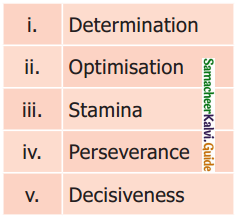
Answer:
Get into groups of four. Each group will choose one quality to talk about to the whole class for about one minute. But before you talk, you have two minutes to think about it. You can make notes if you wish.
J. Prepare a speech in about 80-100 words for the morning assembly, stressing on the importance of games and sports in ensuring a healthy body and mind.
Answer:
The importance of games and sports (Speech)
It is my proud privilege to stand before you to share with you the importance of games and sports today.
“A sound mind in a sound body” is a well – known proverb. Sports and games play a vital role in developing moral, physical, social and spiritual skills of the students, when the students play together they learn to obey the rules. They respect the merits of the opponent team. They develop sportsmanship. This helps the students take success and failure with equanimity of mind. When they play regularly, they keep themselves physically fit and free from diseases. The government has made sports and games compulsory in schools and colleges. It provides all the necessary support to sportsmen.
Sports help them develop the team spirit and competitive nature. All round personality and character building are developed in them. Physical education is a boon to the general education. Academic achievement is made easy by sparing time for sports and games. This reduces stress and tension and keeps the mind fit for their studies. It is the duty of the students to make the best use of available facilities and services provided by the government through the educational institutions.
“Health is Wealth”
![]()
Writing
K. Your friend who lives in another town/city has won his/her championship trophy in the recent sports meet. Write a letter congratulating him/her.
|
Star Street, Dear Ranjit, Yours sincerely To M. Ranjit,
|
L. Collect information from newspapers, magazines, periodicals and books about any two famous sports women. Prepare their profies. Use the following format.
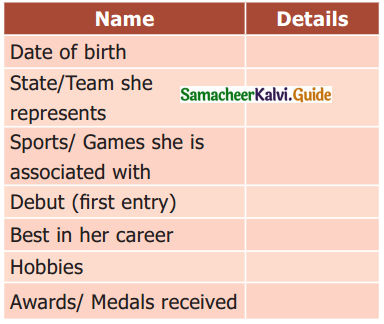
Answer:
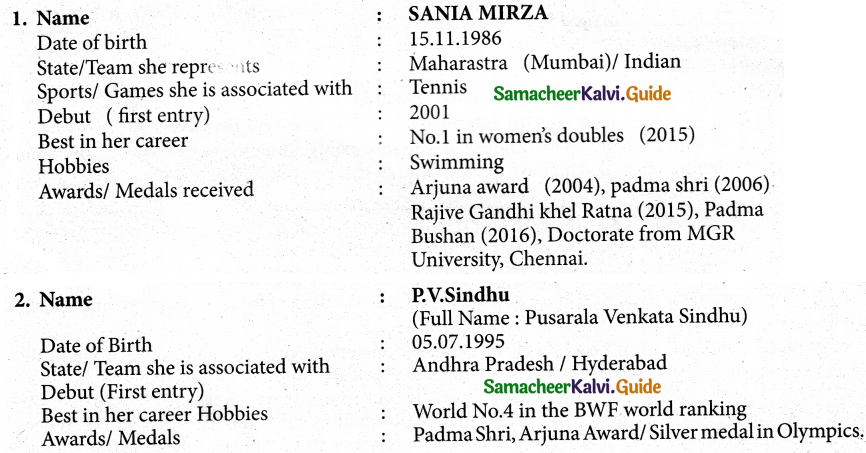
Creative writing
M. Write a newspaper article in about 100 words, comparing the achievements of the two sportswomen based on the information you have already collected.
Answer:
1. Sania Mirza:
Sania hails from Mumbai in Maharastra. She was born on 15th Nov 1981. Santa Mirza is an Indian professional tennis player who was formerly ranked No.l in the womens doubles rankings. From 2003 until her retirement from singles in 2013. She was ranked by the WTA as India’s No.l doubles player. Throughout her career, Mirza has established herself as the most successful female Indian tennis player ever and one of the highest paid arid high profile athletes in the country.
2. P.V.Sindhu:
P.V.Sindhu’s full name is Pusarla Venkata Sindhu. She was born on 05.07.1995 in Hyderabad in Andhra Pradesh. Her coach was Pullela Gopichand Mulyo Handoyo. She is an Indian professional badminton player who is currently world No.4 in the BWF world ranking. At the 2016 summer Olympics, She became the first Indian woman to win an Olympic silver medal. She was awarded Padma Shri and Arjuna Award for badminton,
![]()
Reading:
N. Answer the following question briefly.
Question 1.
What do Tamil Nadu folk dances and folk arts represent ?
Answer:
Tamil Nadu folk dances and folk arts represent the ethos, aesthetic values and melody of the region.
Question 2.
When are folk dances and folk music usually performed ?
Answer:
Folk dances and music are performed during the festivals and community functions.
Question 3.
How is karagaattam performed ?
Answer:
Karagaattam is performed by balancing a pot on the head. The pot is decorated with a cone of flower arrangements topped by a paper parrot.
![]()
Question 4.
How were offerings carried during the ancient period ?
Answer:
During the ancient period! the pilgrims used to carry offerings tied on either end of a long stick, balanced on their shoulders.
Question 5.
Bring out a few differences between the two art forms Therukoothu and Bommalaltam.
Answer:
Therukoothu:
- It is conducted during village festivals in Aadi and panguni.
- It is performed on the streets in the open air by the artistes.
- In this dance form, make up and cos¬tumers are considered importance.
Bommalaltam:
- It is held in rural areas during festivals and fairs
- It is performed on the screen by the skilled puppeteers
- The puppets with strings or wires are manipulated
![]()
Anagrams
O. An anagram is a word or a phrase formed by rearranging the letters of a different word or phrase, typically using all the original letters exactly once.
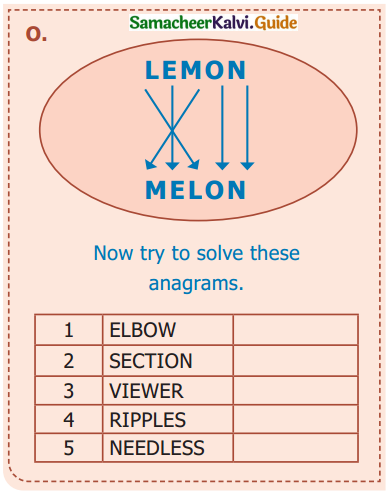
Now try to solve these anagrams
Answer:

P. Work with a partner
Pick out two words from the article on folk culture and folklore of Tamil Nadu with which you can form anagrams. Take turns and ask your partner to solve the anagram and come out with the right words.
Answer:
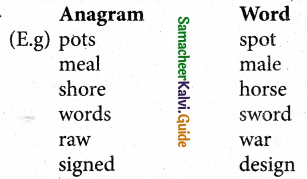
Grammar
A. Choose the most appropriate preposition from the brackets.
- We have been living in Chennai _______ eight years. (for/since)
- Abdul has taken _______ his father. (after!at)
- Vimal generally goes to his workplace bus. (by/on)
- The cricket ball was hidden _____ the leaves, (among/between)
- Mani divided his toys _______ his brothers and sisters, (among/between)
- Mani divided his toys _______ his brother and sister (among / between)
Answer:
- for
- after
- by
- among
- among
- between
![]()
B. Identify the prepositions in the given sentences and underline them.
- Riya borrowed a dress from me and lent it to her friend, Mary.
- When I moved back to the city, things had changed considerably.
- The burglar found the keys under the pot in the balcony.
- Prabhu was hiding behind the door when his sister came looking for him.
- My dog sat on my hat and squashed it.
Answer:
- Riya borrowed a dress from me and lent it to her friend, Mary.
- When I moved back to the city, things had changed considerably.
- The burglar found the keys under the pot in the balcony.
- Prabhu was hiding behind the door when his sister came looking for him.
- My dog sat on my hat and squashed it.
C. Complete the passage by filling in appropriate prepositions from the list- (with, out, in, from, during, of, for, by). Some prepositions may be used more than once.
In Tamil Nadu, a very interesting form of recitation named Villupattu developed (a) …………… the 15th century. Villupattu means bow-song because a bow-shaped musical instrument (b) ……………….. strong high tension string is used (c) ……………… placing it (d) …………….. an earthen pitcher. It is believed that this narrative form was an invention (e) ……………….. Arasa Pulavar. The troupe gives its performance mostly (f) ……………….. temple festivals. There are seven to eight persons in a troupe who form a kind (g) ………………… chorus that supports the main singer-narrator. When the chief narrator sings, the chorus takes (h) ……………… the refrain (i) ………………. the song and repeats it in unison. The whole party sits (j) ………………… the ground and performs (k) ……………… a lot (l) ……………. gesticulation and facial expression to suit the narrative they have taken. The ballad style songs are composed (m) …………………… the rural dialect which appeals (n) ………………… the audience who sometimes join the troupe (o) …………….. suitable notes or words.
Answers:
(a) in
(b) with
(c) for
(d) with
(e) by
(f) during
(g) of
(h) out
(i) from
(j) in
(k) with
(l) of
(m) from
(n) to
(o) with
D. Frame sentences using the prepositional phrase given in the box.
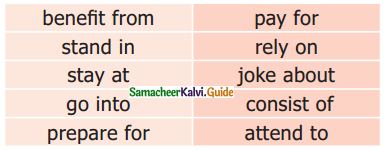
Answers:
- The farmers expect to benefit from the government.
- The Vice – President stands in for the president when he is away.
- She stayed at home when her children were young.
- The plane went into a nose dive.
- I am preparing for the I.A.S examination.
- The rail pass will pay for itself after about two trips.
- We cannot rely on others.
- She often joked about all the things that could go wrong.
- The committee consists of twelve members.
- The nurse attended to the patient.
E. Given below is a picture of a carnival. Complete the factual description by filing in the blanks with appropriate prepositions.
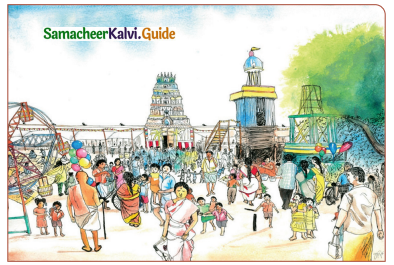
a festive look, as the open spaces are cleaned, spruced up and decorated (a) ……………. colourful streamers. People throng the premises (b) ……………… catch a glimpse (c) …………….. their village deity (d) ………………. a magnificently decorated chariot, and pay their respects. There is a big crowd (e) …………….. the food stalls that serve free piping hot sakkaraipongal (sweet pongal), lemon rice and curd rice. People (f) ………………. nearby villages and towns display their wares attractively, and call out loudly (g) ……………….. the people (h) ……………….. buy their wares. Cotton candy, cut raw mangoes smothered (i) ……………. salt and chilly powder, boiled groundnuts, murukku, sweets, buttermilk, etc., are sold. Men, women, grandmas, grandpas and little children dressed (j) …………………… their best clothes, enjoy the Thiruvizha greatly. You can hear the shrieks (k) ……………… happy children enjoying the rides on ferris wheels and carousels, elders looking (l) ……………………. each other with smiles on their faces. The entire day is spent (m) …………… fun and gaiety. All the village people irrespective of their age, look forward (n) ………………. the thiruvizha every year.
Answers:
(a) with
(b) to
(c) of
(d) on
(e) at
(f) from
(g) at
(h) to
(i) in
(j) in
(k) of
(l) at
(m) in
(n) to
![]()
Writing:
You stayed with your grandparents at your native village during Pongal. You had an unforgettable time with them. You visited the village fair and enjoyed the simple pleasures of life like bathing in the river, strolling in the fields, eating food cooked in earthen utensils over firewood, sleeping on a cot on the terrace under the star-lit sky, visiting temple fairs and watching Karagattam presentation.
F. Write a letter friend, describing the joy of celebrating festivals in a village.
|
52, North Car Street, My dear Suresh, Hope you are fine! I write to you to share my happiness with you. I had been to my native village. It was pongal season. I stayed with my grandparents. I had an unforgettable time with them. I enjoyed bathing in the river. I liked strolling in the fields very much. It was fantastic to see them cooking food in earthen utensils over fire-wood. The meal was very delicious. It was lovely to sleep on a cot on the terrace under the star lit sky. The temple festival fairs were very grand. I enjoyed watching karagaattam which was very spectacular. I missed you very much. You must visit our village next time. Yours Sincerely To A. Suresh |
Project:
G. Your class has to stage a Puppet Show in the Assembly Open Forum on the topic ‘Child Labour’. Divide yourselves into groups and discuss the requirements for the presentation like storyline, characters, dialogues, choice of puppets and music for the interlude: Now complete the dialogues given below.
Ramesh : Let us, present a Puppet Show on CHILD LABOUR for our Assembly Open Forum.
Mohammed : That is a very good idea! Let us start planning right away.
Geetha : (1) ……………………………………………………………………………. ?
Leema : I suggest we begin with the storyline first.
Mani : How (2) ………………………………………………………………..?
Ramesh : We can have around five characters.
Mohammed : What (3) ………………………………………………………… ?
Meena : We can focus on the problems of poverty and illiteracy as the major reasons for child labour.
Ramesh : Can (4) …………………………………………………………………… ?
Leema : I am good at making stick puppets. I will make them myself. But I require some help.
Mani : I (5) ………………………………………………………. Tell me, (6) ……………………………………………. .
Leema : Thank you, Mani. Let us stay back after the meeting and discuss.
Ramesh : Have (7) ………………………………………………………………………………… ?
Meena : I think we should have some music for the interlude.
Geetha : That would make it really interesting. I will get my music group to start working on the tunes for our puppet show.
Answer:
1. What shall we do first?
2. How How many characters can we have?
3. What can we focus on as the major reason for child labour?
4. Can any one make stick puppets?
5. I will help you. Tell me,
6. what I have to do.
7. Have we anything to do for the interlude?
